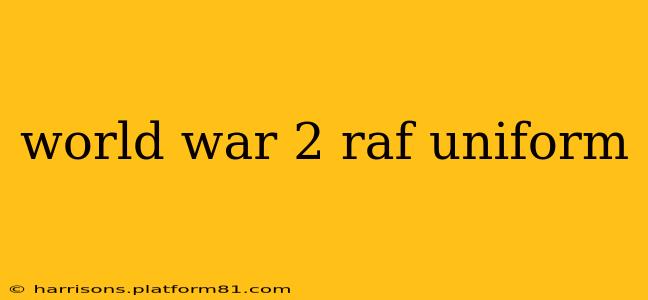The Royal Air Force (RAF) uniforms of World War 2 were as diverse as the missions flown and the personnel involved. From the pilots soaring high above the battlefield to the ground crew ensuring their planes were ready for action, each role had its own specific uniform requirements. This guide delves into the intricacies of these uniforms, exploring the different ranks, branches, and variations that characterized this pivotal period in aviation history.
What were the main components of a standard RAF uniform during WWII?
A standard RAF uniform during World War II generally consisted of several key components, varying based on rank and role. The core elements typically included a tunic (jacket), trousers or breeches (depending on the branch and occasion), a service dress cap, and boots or shoes. Badges of rank, unit insignia, and other decorations adorned the uniform, clearly identifying the wearer's position and achievements. Additional items like a greatcoat for colder weather and various specialist equipment (like flying helmets and goggles for pilots) completed the ensemble. The materials used were generally durable and practical, reflecting the demands of wartime service. For example, battledress was commonly used for ground crew and those involved in more physically demanding roles.
How did RAF uniforms differ between ranks?
Rank differentiation within the RAF during World War II was clearly visible through various insignia and specific uniform details. Officers' uniforms generally featured more elaborate details and higher-quality materials compared to those of airmen. For instance, officers' tunics might have had more intricate braid, while airmen's uniforms were more utilitarian. The placement and type of badges of rank (e.g., pips for officers, chevrons for airmen) also served to instantly distinguish rank. These differences reinforced the hierarchical structure of the RAF and helped maintain order and discipline.
What were the variations in RAF uniforms based on different roles?
RAF uniforms also varied significantly based on the specific roles within the force. Pilots, for example, would wear specialized flying suits and helmets designed for safety and comfort in the cockpit. Ground crew uniforms often incorporated elements of battledress to provide more protection and durability for their work. Other branches, such as the RAF Regiment (the RAF's ground fighting force), had uniforms reflecting their combat roles, incorporating elements similar to those worn by the British Army. These variations ensured that each member of the RAF had appropriate attire for their specific duties.
What were the common colors and materials used in RAF uniforms during WWII?
The most common color for RAF uniforms was blue-gray, often referred to as "air force blue." This muted color provided camouflage and was practical for various operational settings. Materials used ranged from wool for tunics and greatcoats to cotton for shirts and trousers. The quality of the materials and the tailoring could vary depending on the rank and role of the wearer, with officers' uniforms generally using superior materials. The practical needs of wartime also resulted in the adoption of more durable, weather-resistant materials wherever possible.
How did RAF uniforms change throughout the war?
As the war progressed, the designs and materials of RAF uniforms underwent some evolution. Early in the war, uniforms reflected a more traditional military style. However, as the conflict continued and the demand for practicality increased, some aspects of the uniforms were simplified. This streamlining focused on functionality and ease of maintenance, reflecting the pressing needs of a large, rapidly expanding air force engaged in a global conflict. Changes were often subtle, but they represented a gradual adaptation to the demands of war.
What were some notable accessories worn with RAF uniforms?
Various accessories complemented the RAF uniforms of World War II. These included items such as service dress caps, peaked caps, flying helmets, and goggles (essential for pilots), as well as badges of rank, unit insignia, and campaign medals. These accessories provided both functional and decorative elements, further distinguishing rank, role, and accomplishments within the RAF. They often played a crucial role in conveying a soldier's identity and service history.
This comprehensive overview provides a deeper understanding of the diverse and significant role RAF uniforms played during World War II, reflecting both the structure and the vital functions of this pivotal branch of the British armed forces. The uniforms tell a story of dedication, sacrifice, and the crucial contribution of the RAF to Allied victory.
